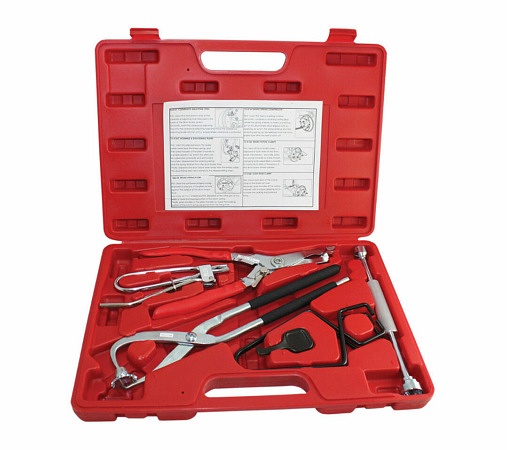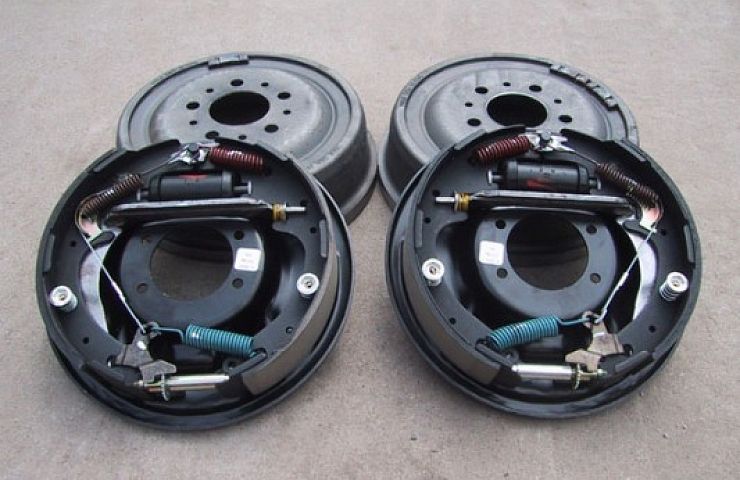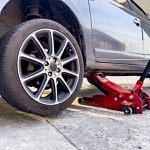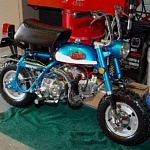Disc brakes may be most common on new cars, but if you drive something built before 2000, chances are you’ve got a set of rear drum brakes. They were the industry standard on all four wheels for years, especially in the 1940s, 1950s, and 1960s, and the design is both simple and pretty effective. Here’s how they work.
Drum Brake Components
In a drum brake setup, you have five major components at each wheel, along with some associated springs and mounting hardware. These five components are the backing plate, two brake shoes, the brake drum, the automatic adjuster, and the wheel cylinder.
How Drum Brakes Work
With drum brakes, when you step on the brake pedal, fluid transfers through the brake line to the wheel cylinder. That cylinder, which is mounted parallel to the wheel on the brake’s backing plate, pushes out against the brake shoes. These also connect to that brake backing plate. The brake drum is machined to slip over the end of the axle’s wheel studs and surround the entire brake system. When you’re driving, it rotates at the same rate as the car’s wheel. So when you hit that brake pedal, the brake shoes push outward against the spinning brake drum. The friction generated slows the wheel down, thereby making your car stop.
What Happens When Rear Drum Brakes Wear?
As your shoe surfaces wear down, the automatic adjuster keeps them correctly placed against the drum. It’s threaded like a bolt, but also has a wheel with teeth that ratchets out as the shoes wear away. In most cases, the adjuster only adjusts when you’re backing up, but you can remove an inspection port in the backing plate and adjust it with a special tool. Some designs actuate with the cable-operated parking brake.
Shaving Thousandths
By design, this system keeps a certain degree of pressure on the brake drums at all times. Oldschool drag racers found a trick that used the system to their advantage – they could back off their brake adjustment to get zero drag on each wheel, which gave them the slightest of edge over a competitor who didn’t. And in a world where a thousandth of a second can mean a win or a loss, it was a popular trick. But I can tell you from experience – stopping a 110-mph 3,500-lb drag car with four-wheel drums can be scary, especially if you’re used to the easy straight-line stopping of discs.
Drum Brake Drawbacks
Drum brakes are simple, but they do have some drawbacks. The first is heat. Drum brakes aren’t effective at eliminating heat the same way as disc brakes. When they get hot, they tend to fade and stop working. Overheating a set of four wheel drum brakes is easy to do. When that happens you’ll have a hard time getting the car to stop. Other drawbacks include noise from the drum, inconsistent pulling from side to side when on the brakes (especially with front-mounted drums), and wheel cylinders that can start leaking if your car sits too long without being used. When that happens, better plan on a new set of brake shoes – once fouled with fluid, shoes can become ineffective.
Drum / Disc Combos are Common
Discs are a much more efficient design. By the mid-1960s, most car builders in the U.S. had switched over, at least for front wheel systems. Why? Because front brakes do most of the braking, and the discs just worked better. But for years, it was common to see discs on the front and drums on the rear, especially on SUVs and trucks. The Chevrolet Suburban is a good example of a later-model truck that still featured drums in the rear.
Working on Rear Drum Brakes Takes Patience and the Proper Tools
A lot of shadetree mechanics draw the line at working on drum brakes. Blame this on the springs and mounting hardware that can look like a dusty, dirty, painful puzzle. I was a tech for years, and I did a lot of drum brakes when I was wrenching – all you need is a little time, the right brake tools, and one piece of advice: if you’re going to work on your own drum brakes, take one side apart at a time. The other can serve as a roadmap for how the system goes back together. A full service includes replacing the drums, shoes, and drum brake spring kit with fresh components.

This comprehensive drum brake kit includes brake spring pliers, clearance adjusting tool, brake spring compressor, and brake piston clamps.
So there you have it – the ins and outs of drum brakes. If you have a set of rear drum brakes on your car or truck and they’re in good working order, there’s really no reason to swap to discs. But if you want the best stopping ability possible, you might think about it. The drum brakes vs disc brakes consideration comes down to this: how much do you want to spend for more stopping power?
Learn more about modern stopping power from power disc brakes by reading our Disc Brakes 101 post.





